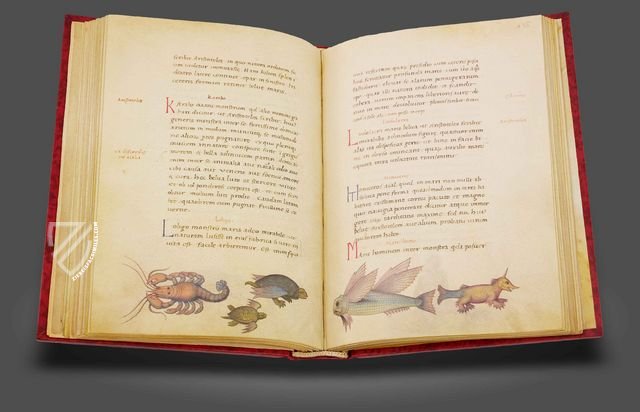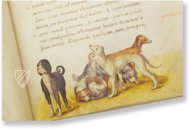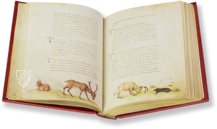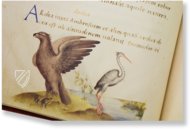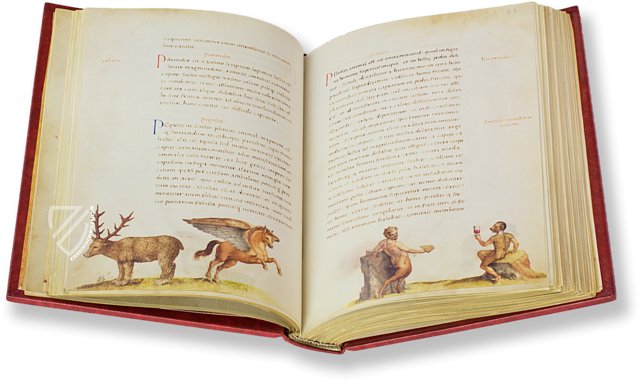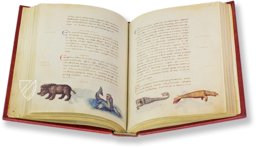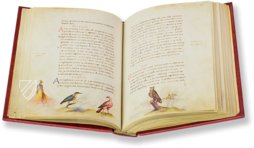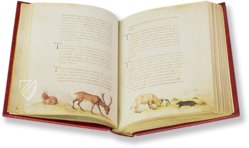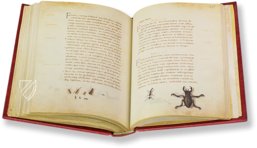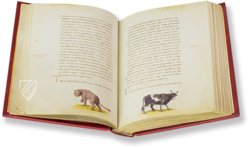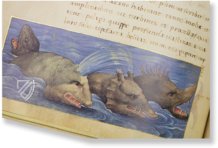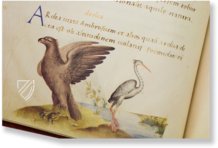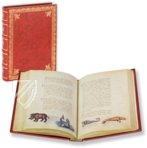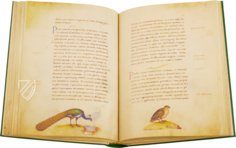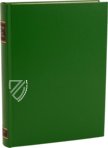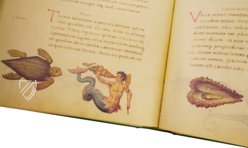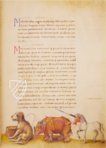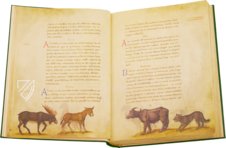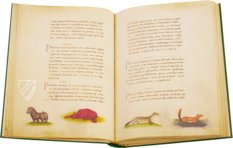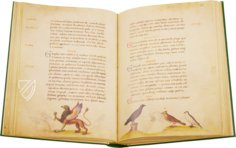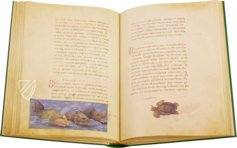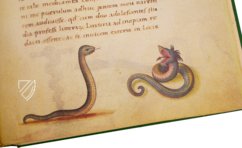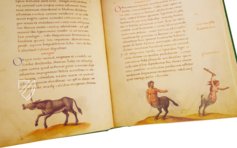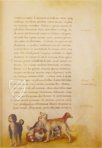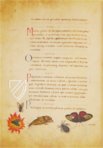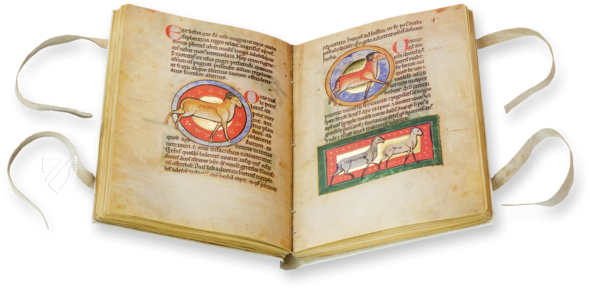The Animal Book of Pier Candido
(1,000€ - 3,000€)
The magnificently illuminated Animal Book of Pier Candido was originally written in Italy ca. 1460. Also known as Pietro, Candido Decembrio was a humanist scholar and author who served as the secretary to numerous important Renaissance princes and even worked at the chancery of Pope Nicholas V. His Latin text describing natural history and the life of animals was appended by an anonymous master ca. 1550 with over 200 bas-de-page miniatures containing a total of 496 animals, birds, and insects, some of which are adorned with gold and silver highlights. Satyrs and hybrids as well as other mythological creatures like the Pegasus are depicted side by side with real animals and are painted with the same attention to detail. These incredibly artful and naturalistic miniatures are fine specimens demonstrating the level of refinement reached by Italian Renaissance artists during the Cinquecento.
The Animal Book of Pier Candido
There is a highly valuable collection of zoological manuscripts in the Apostolic Library of the Vatican. Descriptions and depictions of animals of all kinds, as they were seen in nature by the respective book masters, are found in these books. Our modern biological knowledge naturally did not yet play any role at that time. One of the most famous works of this kind is The Animal Book of Pier Candido. It is an astounding encyclopedia, which was able to combine contemporary natural studies with medieval myths and legends. The work was created ca. 1460 and was endowed with a total of 496 colored and gold-adorned illustrations around 100 years later.
Pier Candido the Humanist
The Italian Pier Candido Decembrio, called Petrus Candidus in Latin, was born ca. 1399 and died in 1477 in Milan. He was one of the most famous humanists of his time and was an influential politician in Italy. He worked for a long time at the court of the Milanese Duke Filippo Maria Visconti, for whom he wrote a biography. Candido produced numerous writings and translations. On his tombstone, a total of 127 titles for which he was responsible are recorded. Probably his most famous work is the “bestiary” – his Animal Book.
The Animal Life of the Renaissance
Ludovico Gonzaga, Marquis of Mantua, commissioned the lexicon. The Marquis was famous as a great lover of animals. Candido composed a work that contained all of the natural scientific information which was known in 1460. He allowed for the influence of mythological stories and in doing so created an informative and exciting book, which was illuminated with colorful images ca. 1550. The miniatures show realistic animal figures in eight different colors. Many of the miniatures were additionally embellished with decorative elements of gold and silver. The book margins were set in 23 carat gold. The natural history of the Renaissance was bound here in one of the Vatican’s most splendid codices.
Codicology
- Alternative Titles
- Tierbuch des Petrus Candidus
De omnium animalium natura
De animantium naturis
Bestiary of Petrus Candidus: Book of Animals
Il libro degli animali di Pietro Candido Decembrio - Size / Format
- 472 pages / 27.0 × 20.0 cm
- Origin
- Italy
- Date
- Written ca. 1460; Illuminated ca. 1550
- Epochs
- Style
- Language
- Illustrations
- 469 colored, detailed animal illustrations at the bottom of the pages
- Artist / School
- Pier Candido Decembrio (1399–1477)
The Animal Book of Pier Candido
Frogs
Frogs are an important part of the ecosystem and possess cultural importance across the world. In folklore, frogs are used as metaphors for those possessing hidden talents in spite of their appearance. Medieval theologians distinguished between land and water frogs, regarding the former as righteous while the latter were sinful. A variety of frogs are presented here in artful and natural detail alongside a succulent grasshopper, a fine feast for a frog.
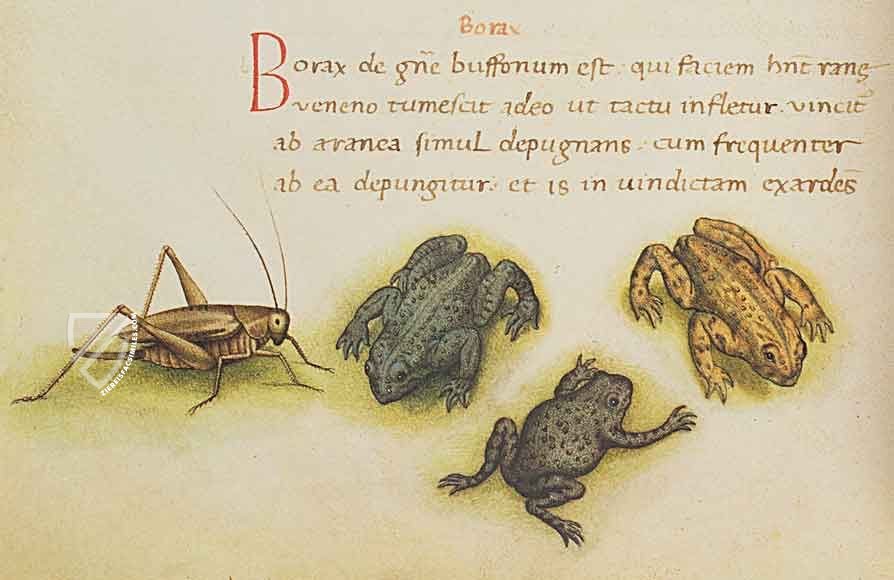
The Animal Book of Pier Candido
On Horses
The horse was an animal of tremendous importance for both war and peace during the Middle Ages, especially for a great nobleman like the Milanese Duke Filippo Maria Visconti, who commissioned this work. This bas-de-page miniature is a fine specimen of Italian Renaissance art and displays the skill of the great master Pietro Candido.
On a bright field of gold, we see ten horses running, bucking, and playing with one another. Each is colored individually – some are solid shades of brown or gray, others are mottled, all have flowing manes and tails as well as friendly facial expressions. They are presented in a very naturalistic manner with close attention paid to producing realistic proportions, musculature, shading, and shadows.
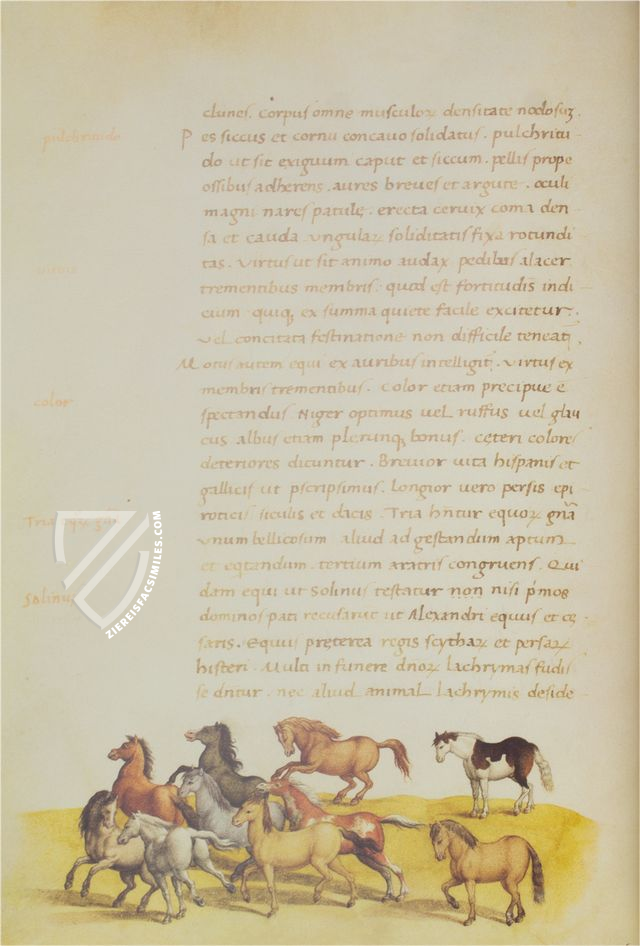
#1 Tierbuch des Petrus Candidus (Leather edition)
Languages: English, German
(1,000€ - 3,000€)
#2 Tierbuch des Petrus Candidus (Linen edition)
Languages: English, German
- Treatises / Secular Books
- Apocalypses / Beatus
- Astronomy / Astrology
- Bestiaries
- Bibles / Gospels
- Chronicles / History / Law
- Geography / Maps
- Saints' Lives
- Islam / Oriental
- Judaism / Hebrew
- Single Leaf Collections
- Leonardo da Vinci
- Literature / Poetry
- Liturgical Manuscripts
- Medicine / Botany / Alchemy
- Music
- Mythology / Prophecies
- Psalters
- Other Religious Books
- Games / Hunting
- Private Devotion Books
- Other Genres
- Afghanistan
- Armenia
- Austria
- Belgium
- Colombia
- Croatia
- Cyprus
- Czech Republic
- Denmark
- Egypt
- Ethiopia
- France
- Germany
- Greece
- Hungary
- India
- Iran
- Iraq
- Israel
- Italy
- Japan
- Lebanon
- Luxembourg
- Mexico
- Morocco
- Netherlands
- Palestine
- Peru
- Poland
- Portugal
- Russia
- Serbia
- Spain
- Sri Lanka
- Sweden
- Switzerland
- Syria
- Turkey
- Ukraine
- United Kingdom
- United States
- Uzbekistan
- Aboca Museum
- Ajuntament de Valencia
- Akademie Verlag
- Akademische Druck- u. Verlagsanstalt (ADEVA)
- Aldo Ausilio Editore - Bottega d’Erasmo
- Alecto Historical Editions
- Alkuin Verlag
- Almqvist & Wiksell
- Amilcare Pizzi
- Andreas & Andreas Verlagsbuchhandlung
- Archa 90
- Archiv Verlag
- Archivi Edizioni
- Arnold Verlag
- ARS
- Ars Magna
- ArtCodex
- AyN Ediciones
- Azimuth Editions
- Badenia Verlag
- Bärenreiter-Verlag
- Belser Verlag
- Belser Verlag / WK Wertkontor
- Benziger Verlag
- Bernardinum Wydawnictwo
- BiblioGemma
- Biblioteca Apostolica Vaticana (Vaticanstadt, Vaticanstadt)
- Bibliotheca Palatina Faksimile Verlag
- Bibliotheca Rara
- Boydell & Brewer
- Bramante Edizioni
- Bredius Genootschap
- Brepols Publishers
- British Library
- C. Weckesser
- Caixa Catalunya
- Canesi
- CAPSA, Ars Scriptoria
- Caratzas Brothers, Publishers
- Carus Verlag
- Casamassima Libri
- Chavane Verlag
- Christian Brandstätter Verlag
- Circulo Cientifico
- Club Bibliófilo Versol
- Club du Livre
- CM Editores
- Collegium Graphicum
- Collezione Apocrifa Da Vinci
- Comissão Nacional para as Comemorações dos Descobrimentos Portugueses
- Coron Verlag
- Corvina
- CTHS
- D. S. Brewer
- Damon
- De Agostini/UTET
- De Nederlandsche Boekhandel
- De Schutter
- Deuschle & Stemmle
- Deutscher Verlag für Kunstwissenschaft
- DIAMM
- Droz
- E. Schreiber Graphische Kunstanstalten
- Ediciones Boreal
- Ediciones Grial
- Ediclube
- Edições Inapa
- Edilan
- Editalia
- Edition Deuschle
- Edition Georg Popp
- Edition Leipzig
- Edition Libri Illustri
- Editiones Reales Sitios S. L.
- Éditions de l'Oiseau Lyre
- Editions Medicina Rara
- Editorial Casariego
- Editorial Mintzoa
- Editrice Antenore
- Editrice Velar
- Edizioni Edison
- Egeria, S.L.
- Eikon Editores
- Electa
- Emery Walker Limited
- Enciclopèdia Catalana
- Eos-Verlag
- Ephesus Publishing
- Ernst Battenberg
- Eugrammia Press
- Extraordinary Editions
- Fackelverlag
- Facsimila Art & Edition
- Facsimile Editions Ltd.
- Facsimilia Art & Edition Ebert KG
- Faksimile Verlag
- Feuermann Verlag
- Folger Shakespeare Library
- Franco Cosimo Panini Editore
- Friedrich Wittig Verlag
- Fundación Hullera Vasco-Leonesa
- G. Braziller
- Gabriele Mazzotta Editore
- Gebr. Mann Verlag
- Gesellschaft für graphische Industrie
- Getty Research Institute
- Giovanni Domenico de Rossi
- Giunti Editore
- Graffiti
- Grafica European Center of Fine Arts
- Guido Pressler
- Guillermo Blazquez
- Gustav Kiepenheuer
- H. N. Abrams
- Harrassowitz
- Helikon
- Hendrickson Publishers
- Henning Oppermann
- Herder Verlag
- Hes & De Graaf Publishers
- Hoepli
- Holbein-Verlag
- Hortus Deliciarum
- Houghton Library
- Hugo Schmidt Verlag
- Idion Verlag
- Il Bulino, edizioni d'arte
- ILte
- Imago
- Insel Verlag
- Instituto Nacional de Antropología e Historia
- Istituto dell'Enciclopedia Italiana - Treccani
- Istituto Ellenico di Studi Bizantini e Postbizantini
- Istituto Geografico De Agostini
- Istituto Poligrafico e Zecca dello Stato
- Italarte Art Establishments
- J. Thorbecke
- Jan Thorbecke Verlag
- Johnson Reprint Corporation
- Josef Stocker
- Josef Stocker-Schmid
- Jugoslavija
- Karl W. Hiersemann
- Kasper Straube
- Kaydeda Ediciones
- Kindler Verlag / Coron Verlag
- Kodansha International Ltd.
- Konrad Kölbl Verlag
- Kurt Wolff Verlag
- La Liberia dello Stato
- La Linea Editrice
- La Meta Editore
- Lambert Schneider
- Landeskreditbank Baden-Württemberg
- Leo S. Olschki
- Les Incunables
- Library of Congress
- Libreria Musicale Italiana
- Lichtdruck
- Lito Immagine Editore
- Lumen Artis
- Lund Humphries
- M. Moleiro Editor
- Maison des Sciences de l'homme et de la société de Poitiers
- Manuscriptum
- Martinus Nijhoff
- Maruzen-Yushodo Co. Ltd.
- MASA
- McGraw-Hill
- Militos
- Millennium Liber
- Müller & Schindler
- Nahar and Steimatzky
- National Library of Wales
- Neri Pozza
- Nova Charta
- Oceanum Verlag
- Odeon
- Orbis Mediaevalis
- Orbis Pictus
- Österreichische Staatsdruckerei
- Oxford University Press
- Pageant Books
- Parzellers Buchverlag
- Patrimonio Ediciones
- Pattloch Verlag
- PIAF
- Pieper Verlag
- Plon-Nourrit et cie
- Prestel Verlag
- Princeton University Press
- Prisma Verlag
- Priuli & Verlucca, editori
- Pro Sport Verlag
- Propyläen Verlag
- Pytheas Books
- Quaternio Verlag Luzern
- Reales Sitios
- Recht-Verlag
- Reichert Verlag
- Reichsdruckerei
- Riehn & Reusch
- Roberto Vattori Editore
- Rosenkilde and Bagger
- Roxburghe Club
- Salerno Editrice
- Sarajevo Svjetlost
- Schöck ArtPrint Kft.
- Scolar Press
- Scrinium
- Scripta Maneant
- Scriptorium
- Siloé, arte y bibliofilia
- SISMEL - Edizioni del Galluzzo
- Sociedad Mexicana de Antropología
- Société des Bibliophiles & Iconophiles de Belgique
- Soncin Publishing
- Sorli Ediciones
- Stainer and Bell
- Studer
- Styria Verlag
- Sumptibus Pragopress
- Szegedi Tudomànyegyetem
- Taberna Libraria
- Tarshish Books
- Taschen
- Tempus Libri
- Testimonio Compañía Editorial
- Thames and Hudson
- The Clear Vue Publishing Partnership Limited
- The Facsimile Codex
- The Folio Society
- The Marquess of Normanby
- The Richard III and Yorkist History Trust
- Tip.Le.Co
- TouchArt
- TREC Publishing House
- TRI Publishing Co.
- Trident Editore
- Typis Regiae Officinae Polygraphicae
- Union Verlag Berlin
- Universidad de Granada
- University of California Press
- University of Chicago Press
- Urs Graf
- Vallecchi
- Van Wijnen
- VCH, Acta Humaniora
- VDI Verlag
- VEB Deutscher Verlag für Musik
- Verlag Anton Pustet / Andreas Verlag
- Verlag Bibliophile Drucke Josef Stocker
- Verlag der Münchner Drucke
- Verlag für Regionalgeschichte
- Verlag Styria
- Vicent Garcia Editores
- W. Turnowsky
- Waanders Printers
- Wiener Mechitharisten-Congregation (Wien, Österreich)
- Wissenschaftliche Buchgesellschaft
- Wydawnictwo Dolnoslaskie
- Xuntanza Editorial
- Zakład Narodowy
- Zollikofer AG

